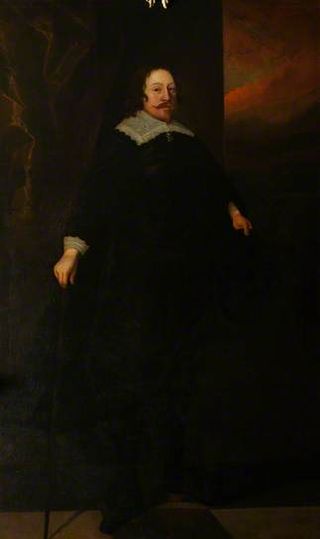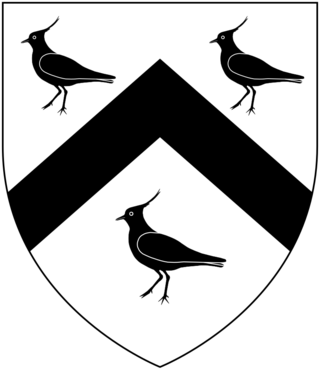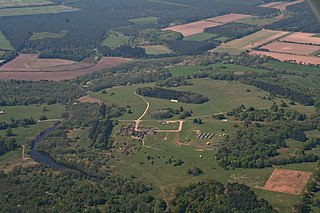
Chavenage House, Tetbury, Gloucestershire is a country house dating from the late 16th century. The house was built in 1576 and is constructed of Cotswold stone, with a Cotswold stone tiled roof. David Verey and Alan Brooks, in their Gloucestershire Pevsner, describe the house as "the ideal sixteenth-century Cotswold stone manor house". Chavenage is a Grade I listed building.

Sir John Lyttelton was an English nobleman, politician, knight, and landowner from the Lyttelton family during the Tudor period.
William Mew (Mewe) was an English clergyman, a member of the Westminster Assembly. He is known also for a drama, Pseudomagia, and for the contribution to beekeeping of the design for a transparent hive.

Chaloner Chute I of The Vyne, Sherborne St John, Hampshire, was an English lawyer, Member of Parliament and Speaker of the House of Commons during the Commonwealth.
Robert Stephens (1665–1732), who was appointed historiographer royal in 1727, was a public servant and historian. He was the first to publish much of Francis Bacon's private correspondence.
Richard Birde of Whitminster, Gloucestershire, was an English bureaucrat and landowner.
Nathaniel Stephens was an English politician who sat in the House of Commons at various times between 1628 and 1653. He supported the Parliamentarian cause in the English Civil War.

Sir Stephen Soame was an English merchant, landowner and politician who sat in the House of Commons in 1601. He served as Lord Mayor of London for the year 1598 to 1599.
Sir Edward Wynter or Wintour was an English mariner and landowner who sat in the House of Commons at various times between 1587 and 1601. He developed the iron workings around the family estates at Lydney in the Forest of Dean, which in his son's time were of importance to the Royalist cause. His marriage to Lady Anne Somerset produced a strongly Roman Catholic allegiance among his children.
The Manor of Combe Martin was a medieval manor estate in Combe Martin, Devon, England.
William Trye (1660–1717), of Hardwicke, Gloucestershire, was an English politician.
William Combe (1551–1610), of Middle Temple, London and Warwick, was an English politician.

Mount Radford is an historic estate in the parish of St Leonards, adjacent to the east side of the City of Exeter in Devon.

Nicholas Hyett (1709-1777) was a lawyer and justice of the peace in Gloucester, England, and one of the last keepers and constables of the Castle of Gloucester.
John Sotherton the younger (1562–1631) was an English judge, member of a prominent parliamentary, judicial and mercantile family of London and East Anglia, who became Cursitor Baron of the Exchequer in 1610.

John Twynyho of Cirencester, Bristol and Lechlade, all in Gloucestershire, was a lawyer and wealthy wool merchant who served as Recorder of Bristol, as a Member of Parliament for Bristol in Gloucestershire in 1472-5 and in 1484 and for the prestigious county seat Gloucestershire in 1476. In 1478 he was Attorney General to Lord Edward (the future King Edward V, eldest son and heir of King Edward IV.
Sir Walter Denys of Dyrham, Gloucestershire was a Tudor landowner and member of Parliament.

Parke is an historic estate in the parish of Bovey Tracey in Devon, England. The present mansion house known as Parke House, a grade II listed building situated 1/2 mile west of the centre of the town of Bovey Tracey and on the opposite side of the River Bovey, was rebuilt in 1826/8 by William Hole (1799-1859) and is today the headquarters of the Dartmoor National Park Authority.

The title Baron Cobham has been created numerous times in the Peerage of England; often multiple creations have been extant simultaneously, especially in the fourteenth century.

Buckenham Tofts is a former civil parish, now in the parish of Stanford, in the Breckland district, in the county of Norfolk, England, situated about 7 miles north of Thetford, and since 1942 situated within the Stanford Training Area, a 30,000-acre military training ground closed to the public. It was situated about one mile south of the small village of Langford, with its Church of St Andrew, and about one mile west of Stanford, with its All Saints' Church and one mile north of West Tofts, with its Church of St Mary, all deserted and demolished villages. None of these settlements are shown on modern maps but are simply replaced by "Danger Area" in red capital letters. In 1931 the parish had a population of 60. On 1 April 1935 the parish was abolished and merged with Stanford.